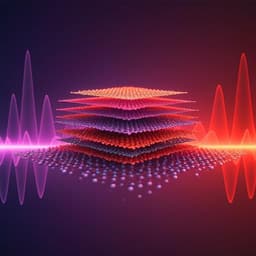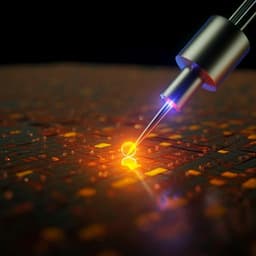
Chemistry
Free charge photogeneration in a single component high photovoltaic efficiency organic semiconductor
M. B. Price, P. A. Hume, et al.
Discover the breakthrough in organic photovoltaics where a single molecule, Y6, demonstrates the ability to generate free charges without requiring a heterojunction. This research, conducted by a team from Victoria University of Wellington and Peking University, challenges conventional OPV understanding and opens new avenues for efficient solar energy solutions.
~3 min • Beginner • English
Introduction
The study addresses whether an organic semiconductor can intrinsically generate free charges upon photoexcitation, without requiring a donor–acceptor heterojunction. Conventional OPVs rely on exciton formation and interfacial splitting due to low dielectric constants, which imposes efficiency limits and complexity. Y6, a fused-ring non-fullerene acceptor with low bandgap and high dielectric constant/refractive index, challenges this paradigm. The authors hypothesize that neat Y6 films can produce a majority of free charges intrinsically, driven by reduced exciton binding energy and strong exciton–charge-transfer (CT) coupling, and they seek to quantify free charge yield and elucidate kinetics and molecular origins. The work aims to redefine OPV operation and inform device design prioritizing intrinsic charge generation and reduced recombination.
Literature Review
- Traditional OPVs: Low dielectric constants (~3–4) lead to tightly bound Frenkel excitons; efficient operation requires donor–acceptor heterojunctions to split excitons, but introduces voltage losses, instability, and morphological complexity.
- Prior observations: Some field-assisted or extrinsic charge formation in neat organics and significant CT/polaron-pair formation in push–pull systems have been reported, but not majority free charge generation undergoing bimolecular recombination.
- FREAs (fused-ring electron acceptors), notably Y6, have driven record OPV efficiencies and exhibit high refractive indices/dielectric constants and exciton/electron delocalization.
- Observations in PM6:Y6 blends include barrierless charge generation, intensity-dependent increases in charge generation, and intra-moiety CT-like intermediates, interpreted via CT-state frameworks.
- Saha–Langmuir framework from inorganic semiconductors relates free charge fraction to dielectric constant, effective mass, temperature, and exciton binding energy. Estimated Y6 exciton binding energy ~100–250 meV suggests potentially high intrinsic free charge fractions (20–80%).
Methodology
- Materials and Film Preparation: Neat Y6 and blends (with PTB7-Th, poly-TPD, PCBM) spin-coated from chloroform onto quartz or device substrates; solid solutions Y6:polystyrene (1:50 wt/wt). Film thicknesses measured by profilometry.
- Steady-state Spectroscopy: UV–Vis absorption (Cary 5000, Cary 50 Bio). Photoluminescence (PL) spectra (Cary Eclipse). PL quantum efficiency (PLQE) measured in an integrating sphere via de Mello method; intensity-dependent PLQE using 532 nm, 600 ps Q-switched Nd:YAG pulses at 25 kHz.
- Transient Absorption (TA) Spectroscopy: Home-built setup; 100–150 fs pulses at 3 kHz (800 nm fundamental) with TOPAS OPA for tunable excitation (e.g., 550–800 nm). White-light probe from YAG crystal; detection via prism spectrometer with CMOS/InGaAs arrays. Magic angle polarization; samples under vacuum/N2; multiple fluences (~10^16–10^18 cm^-3). Spectral decomposition using singular value decomposition, multivariate curve resolution, and a genetic algorithm to isolate exciton and charge/CT spectra and kinetics.
- Time-Resolved Terahertz Spectroscopy (OPTP): Optical pump–THz probe with ZnTe generation/detection; dual lock-in detection; pump chopped at 750 Hz; conductivity Δσ extracted from THz transmission changes; beam paths in dry air; samples in N2.
- Ultrafast PL Up-Conversion: Yb fiber laser (44 kHz, 150 fs); 515 nm excitation; sum-frequency generation in BBO (type I) with 1030 nm gate; spectral detection at 480 nm; temporal scans with motorized delay; samples under vacuum.
- Device Fabrication and Characterization: Single-component Y6 cells: ITO/PEDOT:PSS (or PCP-Na)/Y6/LiF/Al; active layer ~30 nm. Dilute donor devices: ITO/PEDOT:PSS/PTB7-Th:Y6/PNDIT-F3N/Ag. JV under N2 with calibrated solar simulator; Jsc vs light intensity (0.01–>2 suns) to extract power-law exponent α; EQE spectra measured (Enlitech QE-R3011).
- Kinetic Modeling: Minimal model including prompt exciton S1* formation, rapid S1*→S1 and S1*→free charges (FC), interconversion, bimolecular charge recombination to singlets/triplets, and nonradiative trap-mediated recombination (notably hole traps); optional inclusion of triplet–triplet annihilation and explicit trap terms. Global fitting to TA kinetics across fluences and PLQE vs excitation density. Internal PLQE estimated accounting for photon reabsorption/recycling following Richter et al.
- Quantum-Chemical Calculations: DFT/TD-DFT (Gaussian 09) with CAM-B3LYP/6-31+G(d,p), TDA, PCM (ε=5.0); non-empirical range tuning for CT states (optimal ω=0.010 Bohr^-1). Electronic couplings obtained by projecting quasi-diabatic exciton/CT states of separated dimers (10 Å) onto adiabatic states in crystal geometry for π–π stacked pairs.
- Density of States (DOS) and Electrostatic Embedding: VOTCA-CTP long-range embedding to compute solid-state IE/EA distributions using distributed multipoles (GDMA) and Thole polarizabilities; Ewald summation; large supercell (8×8×6) thin-film slab with vacuum buffer to emulate ~10 nm film; analysis of layer-dependent polarization and DOS.
- Molecular Dynamics: Desmond (OPLS3e force field) equilibration of Y6 crystal (8×8×6 unit cells) with full side chains; Brownian minimization, NPT equilibration (300 K, 1 atm), followed by trajectory sampling to inform embedding calculations.
Key Findings
- Intensity-dependent PLQE in neat Y6 exhibits a pronounced rise (“hump”) before roll-off, incompatible with purely monomolecular (geminate) radiative recombination or solely trap saturation/TTA, indicating significant radiative bimolecular recombination of intrinsically generated free charges.
- TA spectroscopy resolves distinct spectra/kinetics of singlet excitons and charges/CT states. A rapid, fluence-independent interconversion within ~2.5 ps is observed, consistent with early delocalization-driven charge formation. Triplet formation is delayed, consistent with non-geminate pathways.
- Time-resolved terahertz conductivity at ~3 ps indicates presence of mobile charges consistent with free-carrier populations (within SNR limits).
- Global kinetic modeling reproduces TA and PLQE data with few parameters, yielding: exciton dissociation probability 0.6–0.9; steady-state free charge fraction 0.65–0.99 at 1 Sun; total carrier density under AM1.5 of ~10^13–10^14 cm^-3. The modeled free charge fraction matches Saha–Langmuir predictions with E_B ≈ 270 meV (m* ~0.5 m_e).
- High refractive index causes strong photon reabsorption; internal PLQE of neat Y6 is ~6% versus measured external ~2%, implying potential for photon recycling if nonradiative losses are reduced.
- Single-component Y6 devices show strong bimolecular/space-charge recombination: Jsc ∝ I^α with α = 0.84 between 0.2–2 Suns; best PCEs: 0.09% (ITO/PEDOT:PSS/Y6/LiF/Al) improved to 0.63% replacing PEDOT:PSS with PCP-Na.
- Adding minute donor content (PTB7-Th:Y6 at 1:50 vs 1:100 wt ratios) yields higher EQE at 1:50. TA shows identical early exciton decay and charge rise (<20 ps) for both, but slower charge recombination for 1:50, indicating donor primarily mitigates recombination rather than aids initial charge generation.
- DFT reveals strong exciton–CT couplings (10–75 meV) with CT states isoenergetic or lower than excitons; CT–ground state coupling is also strong (30–85 meV), rationalizing rapid recombination. Packing-induced differential polarization creates two distinct lattice positions ("...ABBA...") acting as supramolecular donor/acceptor sites, providing an intrinsic driving force (≈0.15–0.3 eV) for charge separation.
- DOS calculations show bimodal hole energetics and layer-dependent ionization energies, confirming distinct polarization environments that favor charge formation and a flat landscape for electron transport.
- Introducing PCBM (20 wt%) without enabling charge transfer modestly reduces recombination, consistent with interfacial level bending effects from quadrupole fields.
- Overall, 60–90% of photoexcited excitons dissociate to charges under relevant conditions, and the majority free charge population undergoes bimolecular recombination.
Discussion
The findings demonstrate that neat Y6 intrinsically generates free charges upon photoexcitation, overturning the assumption that efficient OPVs require donor–acceptor heterojunctions solely for exciton splitting. Spectroscopic evidence and kinetic modeling show high free charge fractions at 1 Sun and bimolecular recombination dynamics, explaining intensity-dependent PLQE behavior. Molecular calculations indicate strong exciton–CT coupling and packing-driven polarization asymmetries that create an intrinsic donor/acceptor motif, providing a kinetic pathway for exciton dissociation and a thermodynamic driving force on the order of the exciton binding energy. These insights reframe the role of bulk heterojunctions in high-efficiency Y6-based devices: rather than primarily splitting excitons, the BHJ mitigates fast recombination by spatially separating carriers and leveraging interfacial level bending from molecular quadrupole fields to funnel holes and suppress non-geminate recombination. The alignment between Saha–Langmuir predictions and kinetic modeling further rationalizes majority free charge generation in a high-dielectric organic semiconductor. Consequently, OPV optimization should emphasize maximizing intrinsic PLQE and free charge yield while suppressing both bimolecular and minority-carrier (trap-assisted) recombination, potentially improving open-circuit voltages and approaching radiative efficiency limits via photon recycling.
Conclusion
This work provides direct evidence that the non-fullerene acceptor Y6 exhibits majority free charge generation in neat films, validated by intensity-dependent PLQE, ultrafast TA, PL up-conversion, and terahertz spectroscopy, and rationalized by kinetic modeling and quantum-chemical analysis of exciton–CT coupling and polarization-driven energetics. Despite high intrinsic charge yields, single-component devices are limited by rapid bimolecular and trap-assisted recombination; sparse donor incorporation slows recombination and enhances EQE without affecting initial dissociation. The results suggest a paradigm shift in OPV design: prioritize materials and morphologies that enhance dielectric screening and exciton–CT coupling to boost intrinsic charge formation, and engineer microstructures to suppress CT–ground state coupling and recombination. Promising future directions include: crystal packing engineering to further increase dielectric constants and free charge fractions; manipulating energy levels via molecular orientation/packing rather than new chemistries; minimizing CT–GS coupling through structural control; exploiting quadrupolar level bending to funnel carriers; and revisiting efficient doped organic p–n junction architectures that leverage intrinsic photogeneration.
Limitations
- High bimolecular recombination and significant hole trapping limit the efficiency of single-component Y6 devices, leading to short minority-carrier diffusion lengths (<15 nm assumed from recombination rates).
- Time-resolved THz spectra support free charge presence but have limited signal-to-noise, constraining precise mobility/DRU interpretations.
- Kinetic model parameters exhibit interdependencies; extracted rate constants carry substantial uncertainties and are model-dependent, though bounds on free charge fractions and dissociation yields are robust.
- While trap saturation and triplet–triplet annihilation may contribute, they cannot solely explain observations; their quantitative roles remain approximate.
- Estimations of exciton binding energy and effective masses used in Saha–Langmuir comparisons introduce assumptions.
- Device-level conclusions drawn from select architectures and thicknesses; broader generalization requires further device optimization and contact engineering.
Related Publications
Explore these studies to deepen your understanding of the subject.







